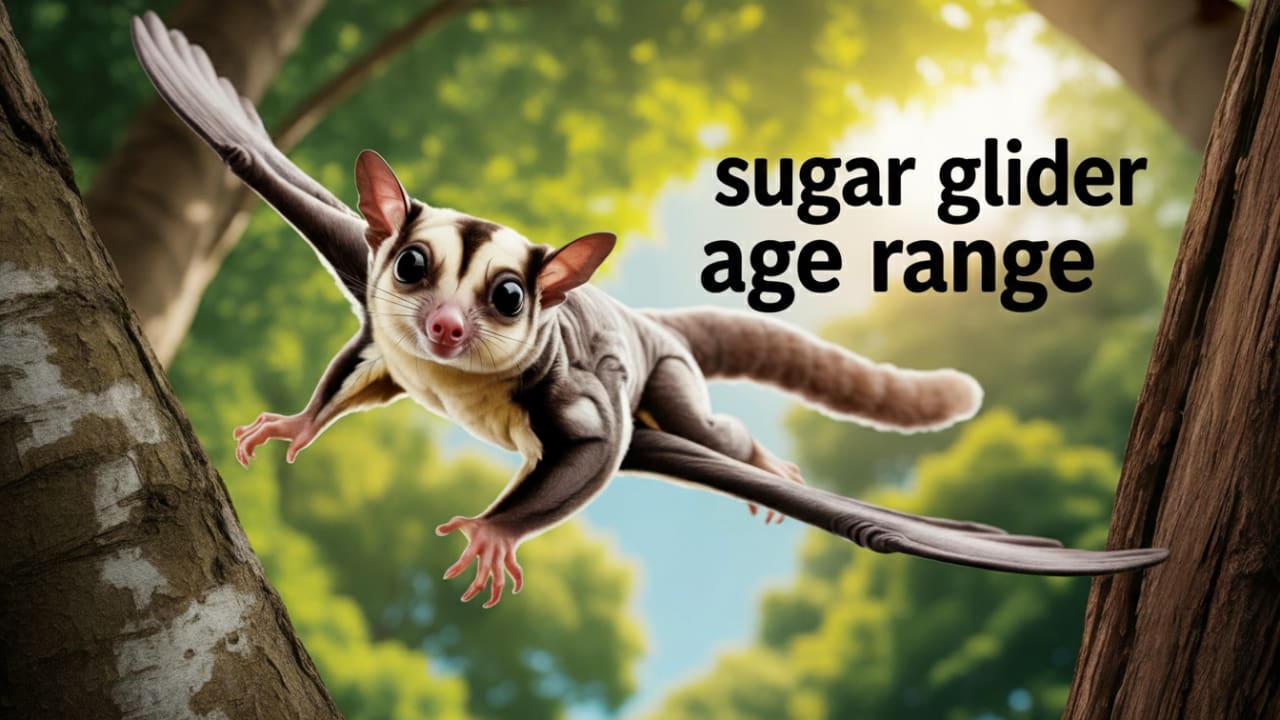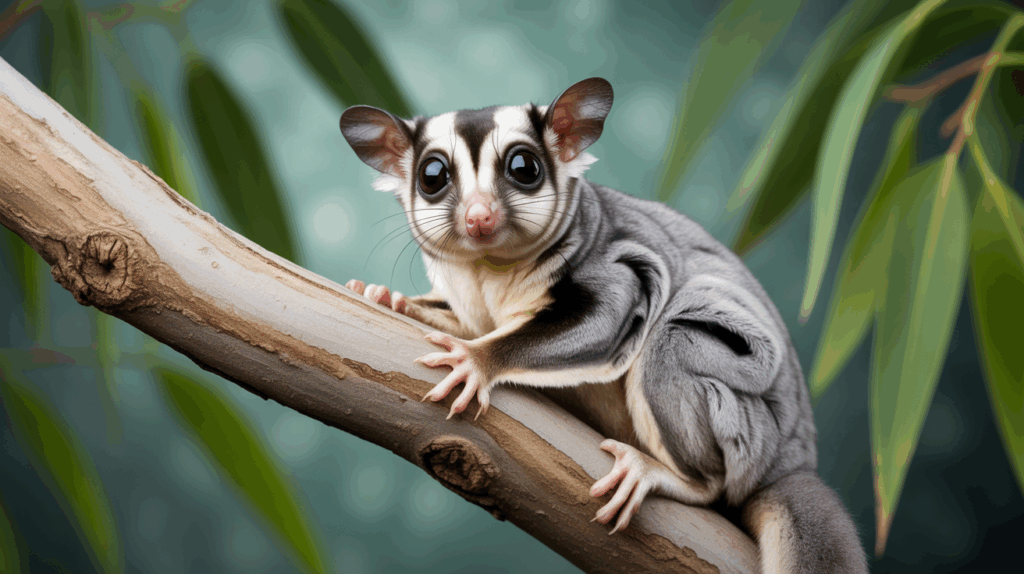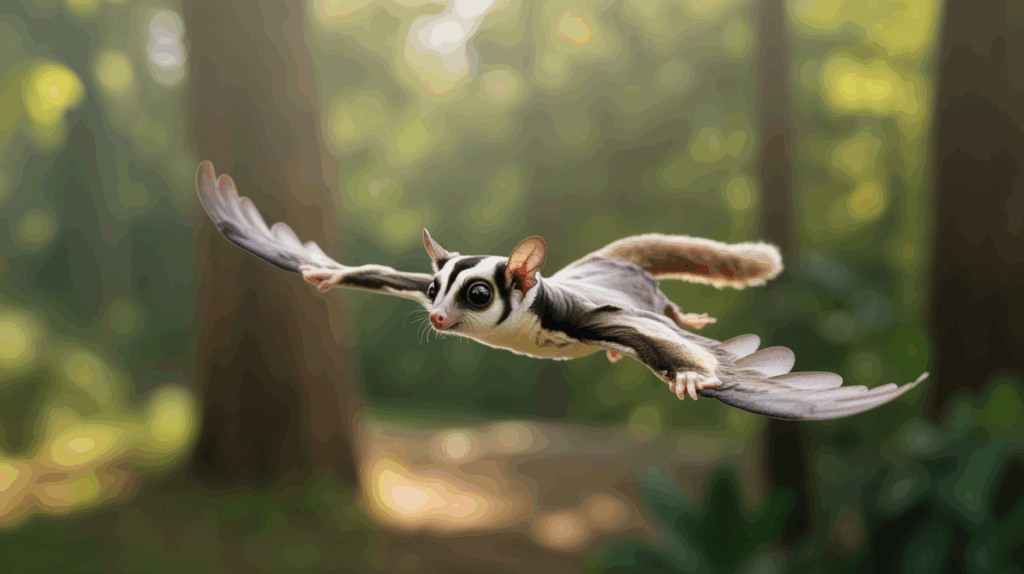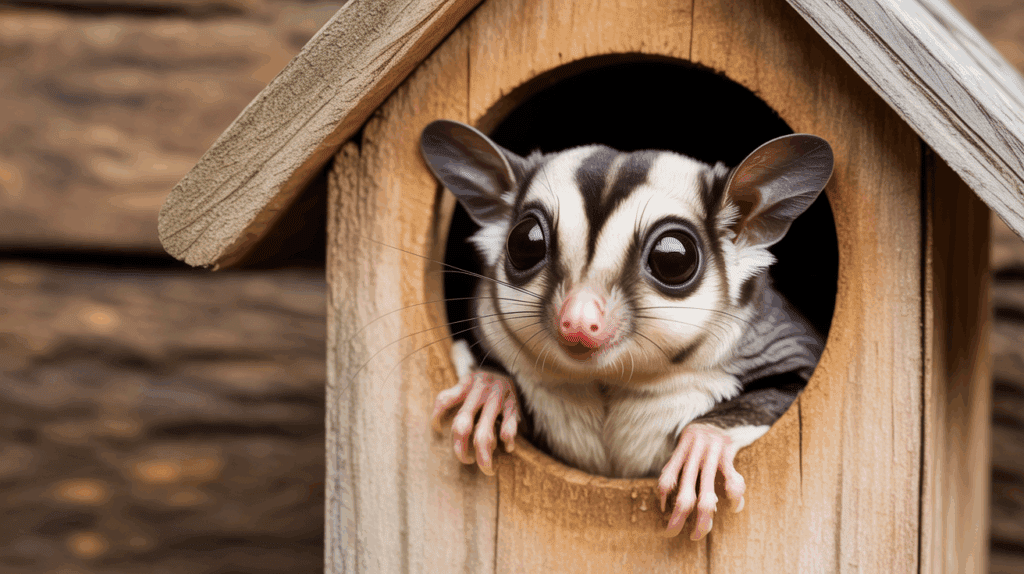
Newsletter Subscribe
Enter your email address below and subscribe to our newsletter

Enter your email address below and subscribe to our newsletter

They are irresistible. Those sugar gliders are tiny, wide-eyed, and so full of life. But you’re not sure what you need to do (or can do) to keep them alive longer.
Now, the average lifespan of a sugar glider in captivity is about 10 to 15 years. This, however, is with the assumption that they receive proper care.
In the wild, these creatures’ lifespan drops sharply because of predators, poor nutrition, and disease. What this means is that keeping them as pets could already be a way to extend their days. You just need to know the right way to take care of them.
Many sugar gliders live short and stressed-out lives because they are kept alone. Others are not fed the proper diets. And some aren’t even given the necessary vet care.
You should avoid solitary housing, as these creatures are very social and need a companion to thrive. You also need to invest in a good diet with calcium-protein balance for these little ones. Lastly, you will have to budget for your pet’s yearly exotic vet visits.
Let’s go ahead and take a look at the costs of keeping your sugar glider. We’ll also debunk some myths like the “5-year lifespan.” And you’ll find some expert-backed, actionable strategies that can help your little one thrive under your care.

While the average sugar glider lifespan is 10–15 years, it’s more accurate to view it as a spectrum shaped by care quality, environment, and genetics. Where a glider falls on this spectrum often reflects the owner’s level of commitment.
This shortened lifespan is most often the result of chronic, unintentional neglect.
Common causes include:
Interestingly, this mirrors their wild lifespan of 4–6 years, where environmental threats are constant. In captivity, such early loss represents a failure to provide the benefits of domestication.
This range reflects responsible ownership. Owners who:
Typically see their gliders thrive within this expected range. Multiple veterinary sources confirm 10–15 years as the standard for well-cared-for sugar gliders.
This is the exceptional standard, reached only by the most dedicated owners.
Key factors include:
The longest recorded sugar glider lifespan in captivity is 17.8 years. While rare, it highlights the potential of what’s possible with extraordinary care.

If you’re checking out that cute little creature in that glass enclosure, you might have asked this question. How long do sugar gliders live? Well, that depends on several factors. The big one with the most influence is their life in the wild versus in captivity.
In the wild, sugar gliders typically live between 3 and 9 years. These little creatures have to fight against natural predators like snakes, owls, and foxes. What’s more, they also face environmental hazards. Some of these include the scarcity of food, habitat loss, and territorial conflicts. Their size and fragile bodies make them quite vulnerable animals, too. So, even a healthy wild sugar glider often does not survive past their first decade.
In captivity, however, sugar gliders can live nearly twice as long. We’re looking at something between 10 and 15 years. But this will have to be accompanied by proper care.
Why is there such a huge difference in lifespan? Well, in captivity, our sugar glider is likely given consistent nutrition. Most (if not all) of us would also provide the little one with veterinary care. Additionally, the environment is quite controlled, so our glider is rather safe from predators and trauma.
Note that exotic pet veterinarians mention that a sugar glider’s lifespan is very heavily influenced by the quality of care and social bonding. So, be sure you check proper housing, nutrition, mental stimulation, and regular checkups off the list if you want your little guy to thrive.
Lastly, don’t think that these animals are “low-maintenance.” Sugar gliders do need almost as much commitment as owning a dog. Keep that in mind.

You really don’t want your little guy to be one of the sugar gliders that barely survive beyond five years. Don’t blame it on luck. Their lifespan is the result of very specific conditions and daily care decisions.
First, you need to know that diet is everything. Your sugar glider needs a balanced and species-appropriate mix of protein. These foods should also be fresh and rich in calcium. Do not feed your little glider just fruits or pellet food. You’ll find that they become malnourished later, having weak bones and organ failure. Try feeding them insects (like mealworms), cooked lean meat, calcium supplements, and different kinds of fruits and veggies.
Exotic pet veterinarians say that a calcium-to-phosphorus imbalance is one of the main silent killers of our gliders. So, take care of your pet’s diet.
That said, diet isn’t the only thing you need to watch out for. Social interaction is very important for your sugar glider to live a longer life. Know that your little guy is a colony dweller by nature. That means, if you keep them alone or even ignore them, they can quickly become depressed. In most cases, this leads to stress-induced illness and even self-mutilating behaviors. To counter this, we recommend you keep at least two bonded gliders together.
Then, there’s housing. Is the cage too cramped for your glider? Is there enough climbing space? What about the ventilation? These factors could stress out your little companion as well. Worse yet, your glider may even face respiratory infections or injuries.
Invest in a proper cage setup. You’ll need vertical climbing space for your sugar glider. Exercise wheels and nesting pouches are also great touches. You can wear a DIY fleece pouch during the day. It helps with bonding while you provide your glider with warmth and security.
Finally, make sure your glider gets their routine vet care. You’ll likely need to take them to specialized exotic vets. And they can be hard to find and expensive. But it’s all worthwhile effort to keep your tiny companion safe and healthy.
The single greatest debate in sugar glider care is diet. For years, many owners relied on pellet-based diets, but leading exotic veterinarians now agree that pellets alone are inadequate and outdated. Most contain fillers, lack bioavailable nutrients, and fail to provide the moisture and variety gliders require.
1. The Leadbeater’s Mixture (BML Variant):
Formulated to replicate the glider’s natural sap- and insect-based diet, this staple slurry is widely recommended.
BML Recipe (Core Ingredients):
2. The HPW (High Protein Wombaroo) Diet:
Developed in Australia, this diet uses Wombaroo High Protein Supplement as a base. It’s praised for its balance, ease of preparation, and consistency.
Most veterinarians recommend feeding sugar gliders in the evening, when they are naturally active.
“Metabolic bone disease from calcium deficiency is one of the most common-and entirely preventable-causes of death in captive sugar gliders.”
– Exotic Veterinary Consensus, 2024
Providing the right diet is not simply about extending lifespan-it’s about preventing painful, irreversible conditions and ensuring your glider thrives, not just survives.
Are you wondering what other options are out there that could keep you company longer? Or maybe you’re just not sure about the commitment you need to put in. Now, how does the average sugar glider life expectancy stack up against other popular exotics, then?
Assuming you take good care of your sugar glider, they can often live an average of 10 to 15 years in captivity. It’s probably one of the longest lifespans you’ll see in the small exotic pet category. So, owning a glider is actually quite a responsibility.
For comparison, hedgehogs (the African pygmy variety) usually live around 4 to 6 years. Hamsters, the common starter pets, have a very short lifespan of about 2 to 3 years, especially the Syrian species. Most rats and mice also have around the same lifespan, rarely living past 2 years. These pets’ short lifespan, however, also means that you have a lower commitment.
There are other exotics that live longer lives. For example, ferrets can usually live between 6 and 10 years. Chinchillas have almost the same lifespan as a sugar glider (10 to 15 years). Parrots can live from 20 to over 50 years. Leopard geckos have a lifespan of 10-20 years. And corn snakes can live for about 15 to 20 years. These pets will require long-term commitment.
Now, let’s check out the cost if you decide to own a sugar glider. Remember, you’ll most likely need to take care of the glider for over a decade, and you’ll most probably be owning at least two of them if you want to keep the animal healthy. So, there’s the expense of food, cage upgrades, and vet visits. You’ll see that all these could easily go over $5,000 to $10,000 over their lifetime.
You’ve probably heard people say things like sugar gliders are easy starter pets and that they only live a few years. That belief couldn’t be more wrong. Let’s debunk some of these myths.
The first one is that sugar gliders only live 5 years. No. They can live up to 10-15 years in captivity with proper care. What this means is that you’ll have a decade-long responsibility. They are not a short-term commitment. Don’t go in with a “trial mindset” and surrender or neglect them once you’re done with your honeymoon phase. That’s probably how the whole 5-year myth got started.
Remember that sugar gliders are nocturnal. They are also highly social, and they need mental stimulation. Don’t go thinking that they can bond better with you if they don’t have another glider companion. If you keep your little guy alone, they can quickly become depressed and withdrawn. They might even start to harm themself.
Another misconception is about their diet. Many of us think that feeding our sugar glider just fruit and human snacks is enough. But you’ll find out eventually that this can cause calcium deficiency, obesity, and metabolic bone disease. Exotic vets even say that an unbalanced diet is one of the major reasons leading to premature death in gliders.
Also, cost is something that people misunderstand as well. Just know that the initial purchase may be under $500. But the cost of taking care of a sugar glider over a lifetime goes beyond several thousand dollars-enclosures, food, toys, and vet bills. They are not exactly “cheap” pets. Annual exams alone can cost something between $75 and $150. Emergencies can often cost you more than $500.
A lot of sugar gliders may not have the chance to reach their full life expectancy. More often than not, it’s not because of diseases. It can be due to preventable mistakes.
The main one is improper diet. You should now know that your sugar glider needs a balance of protein and calcium. So, if you feed them only sugary fruits, seeds, or store-bought pellets, you can expect them to have health problems later. Metabolic bone disease and organ failure are among the common health issues. Remember, don’t assume that something is healthy just because it looks like it or is marketed for small pets.
Next, remember to provide your sugar glider with companionship. Not just you. Your pet needs another mate of the same species to keep them company. You don’t want them suffering from loneliness, anxiety, and depression, after all. These can weaken their immune system over time. They could also affect your pet’s appetite and make them engage in harmful behaviors.
Additionally, make sure the cage is not too small or cluttered. You want the cage to be clean. Doing so could prevent respiratory infections, injuries from unsafe toys, and high stress levels. Also, keep those household cleaners (e.g. aerosol spray) and scented candles away from your pet. They can be toxic. Don’t leave your toilet bowls open. You’d be surprised how many environmental hazards could be hidden in your home.
Then there’s vet neglect. You should not avoid regular checkups, thinking that you can save a few bucks. Early signs of illness in your glider friend are subtle. You may think it’s expensive to pay $100 every year for an exotic vet visit. But fatality might keep you regretting for the rest of your life.
Now, you can love that sugar glider all you want and make all the promises in the world. But are they really compatible with your lifestyle? They demand more than just food and shelter, after all.
Let’s recycle the key question: How many years does a sugar glider live? 10-15 years on average in captivity. And they are active mostly at night. So, if you don’t think your schedule can accommodate late-night activity long-term, this may not work out for you. And if you’re the kind who likes peace and quiet during evenings, you can also stop wanting a glider for a pet. They are vocal, curious, and they need playtime.
As mentioned, sugar gliders don’t do well alone. So, you need to take in another one for a bonded pair. And that means double the cost. Think carefully if you can commit to this long-term. With just one, they may develop stress-related illnesses. With two, it turns into a financial burden.
Also, consider the living space you have. Your sugar glider will need vertical room to climb and glide. The cage must be tall and well-ventilated. One could cost between $200-$400 or more. If you’re one of those who like to use scented candles and air fresheners, you’ll probably have to give them up, too. These, along with other common household cleaners, can be toxic for your little guy.
And let’s not forget legal restrictions. If you’re living in the U.S., some states and cities ban owning sugar gliders. Some may need you to have the proper documentation for owning one. So, always check your local laws before getting an exotic pet.
We’re sure you probably still have questions about sugar gliders and how long they live. Let’s take a look at some of the most frequently asked questions from curious (and often concerned) current and future sugar glider owners.
Yes. Sugar gliders can form deep bonds with you. If you’re consistent in handling them gently from a young age, you’re likely to have a strong bond. Know that bonding is important for your little one’s emotional well-being, too.
If your sugar glider passes suddenly one day, it might be because of silent health issues. This likely has something to do with calcium deficiency, dehydration, poor diet, or prolonged stress. You should know that the symptoms aren’t obvious until it’s too late. So, it’s best to take your glider for regular vet checkups.
Absolutely. Common issues include metabolic bone disease, obesity, dehydration, and dental infections. These conditions are usually caused by an unbalanced diet or a lack of species-specific care.
Yes. They need specialized diets and a social companion. Other than that, you’ll need to provide them with a large cage, mental stimulation, and exotic veterinary care. They are not low-maintenance pets by any stretch.
You might not like the nocturnal activity, odor, and noise. The cost of keeping them is quite high, and there are legal restrictions in some areas. They’re also not ideal for young kids or casual pet owners.
In captivity, they can live between 10 and 15 years. But you need to make sure they are given proper care. In the wild, their average lifespan is about 3–9 years due to predators and environmental threats.
Your sugar glider’s lifespan depends on several factors. These include diet, social environment, vet access, stress levels, genetics, and enclosure quality.
You should never keep your sugar glider alone. These animals are highly social and thrive in pairs or small colonies. A solo glider can become depressed and self-harming.
It includes a protein-based meal plan, calcium supplements, fresh fruits, vegetables, and occasional insects like mealworms. Do not feed your pet sugary treats, and avoid commercial pellets.
No. They’re banned or restricted in several states and cities in America. You should always check your local exotic pet laws before adopting one.
Sugar gliders hide illness expertly. Watch for these early warning signs:
Emergency signs requiring immediate veterinary attention:
Metabolic bone disease results from calcium-phosphorus imbalance and is one of the leading causes of death in pet sugar gliders. Signs include weakness in hind legs progressing to paralysis, tremors, and pathological fractures. This condition is entirely preventable with proper diet but can seem to occur suddenly when gliders have been hiding symptoms.
After having gone through this piece, you should have a better understanding of what affects the average lifespan of a sugar glider. Simply put, it all comes down to informed, consistent care. And know that you’ve already taken your first step.
Be a responsible owner and take care of your glider’s diet, social needs, and their living space. By avoiding the risks mentioned in this article, you should be able to keep your sugar glider active all the way up to their 15th year of life.
There’s no longer any need for guessing. You know what to do to add to the years your little one has. Review your setup, adjust your care routine, and make sure to prioritize their health. Your sugar glider will thank you with years of trust and energy.
Do you have a sugar glider as a pet? How healthy do you think your pet is? Let us know in the comments down below!